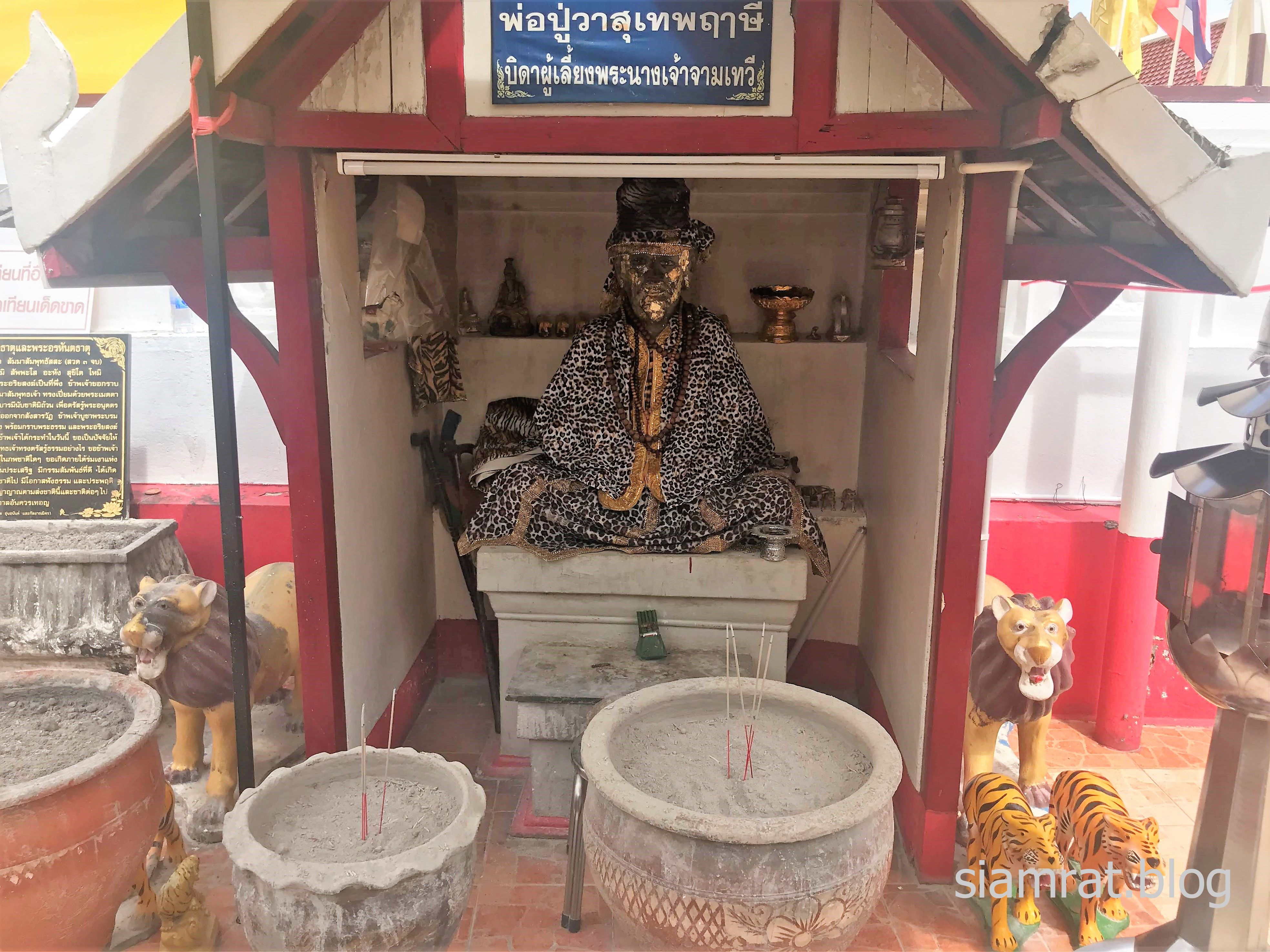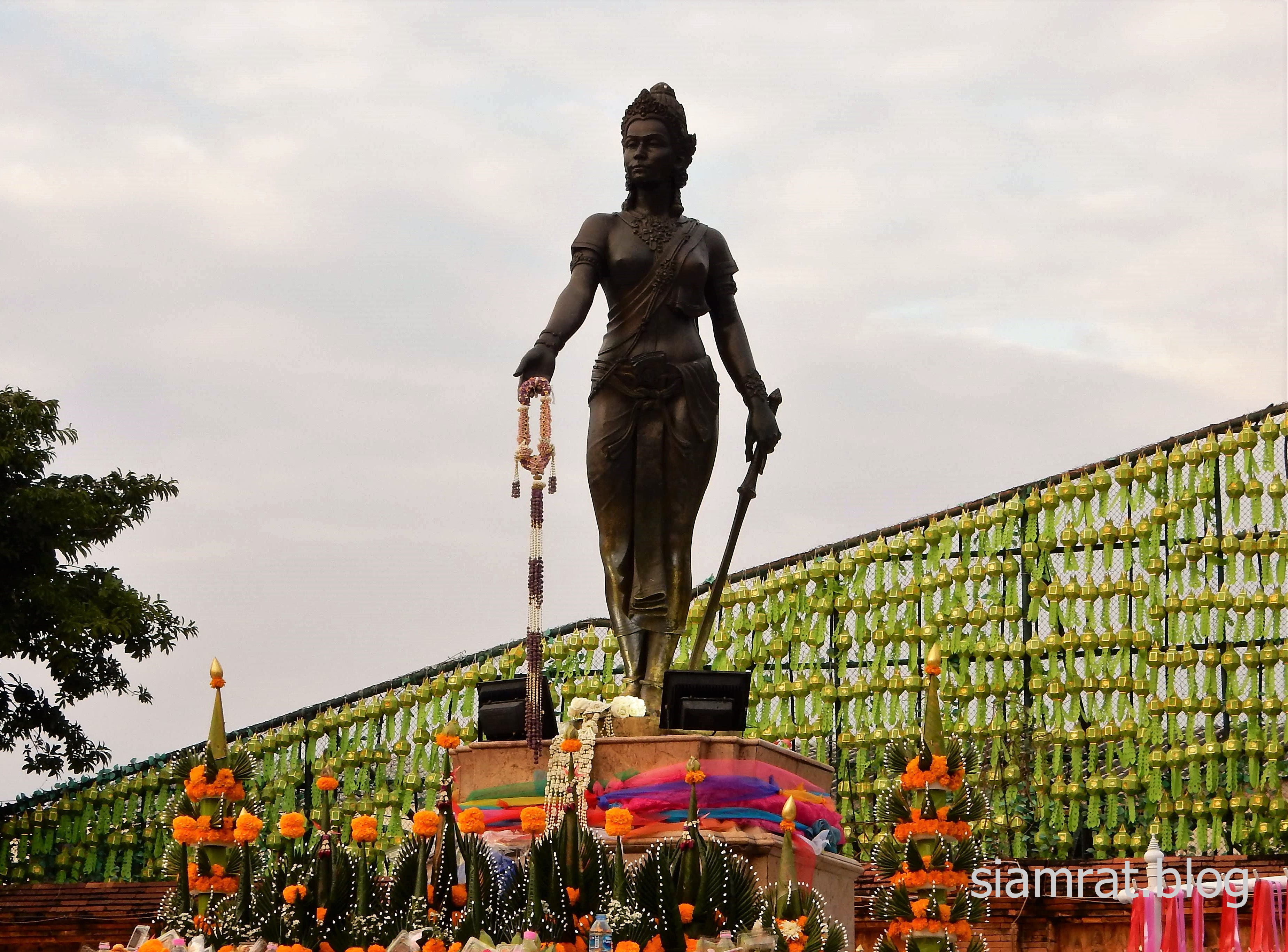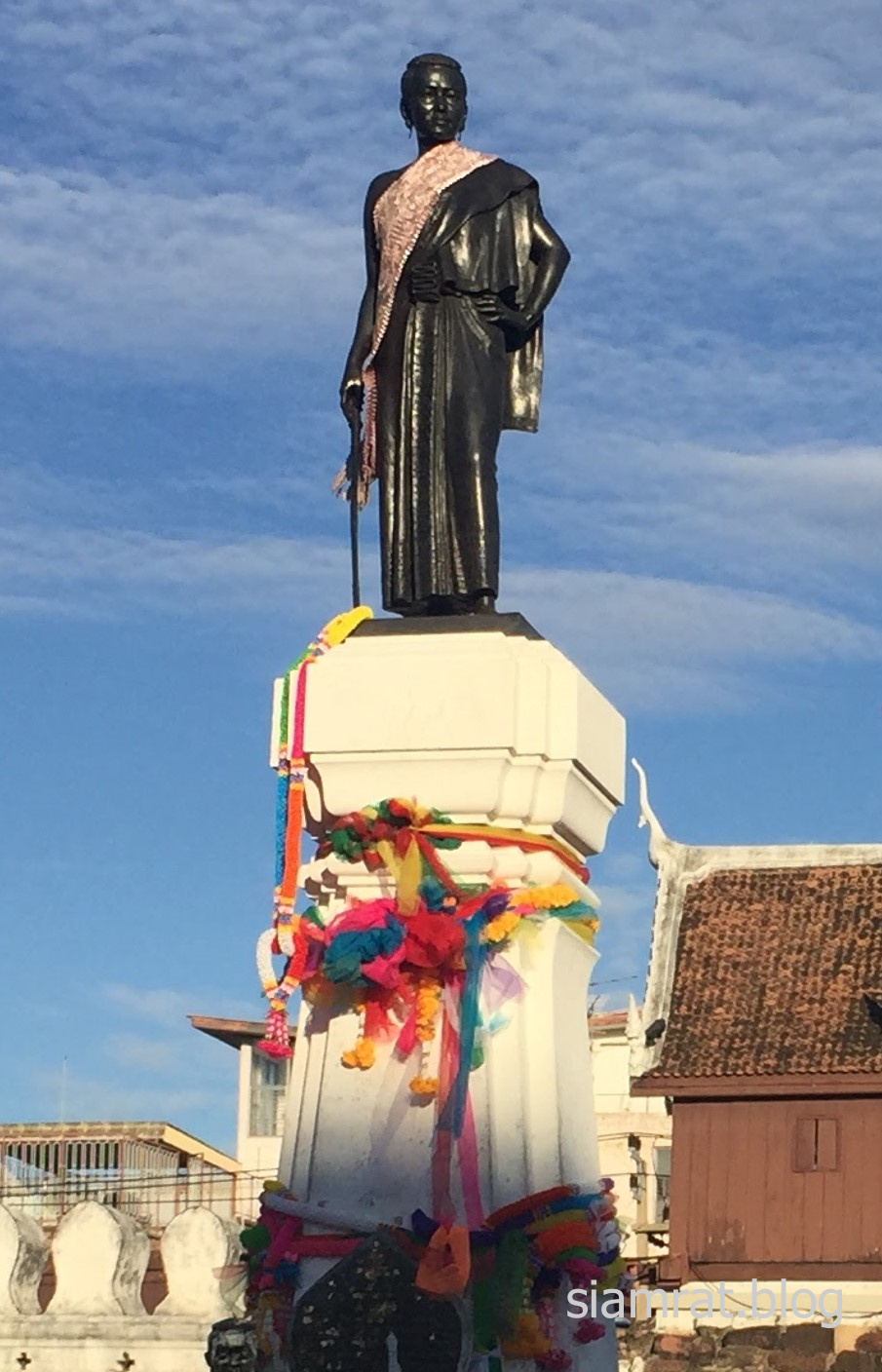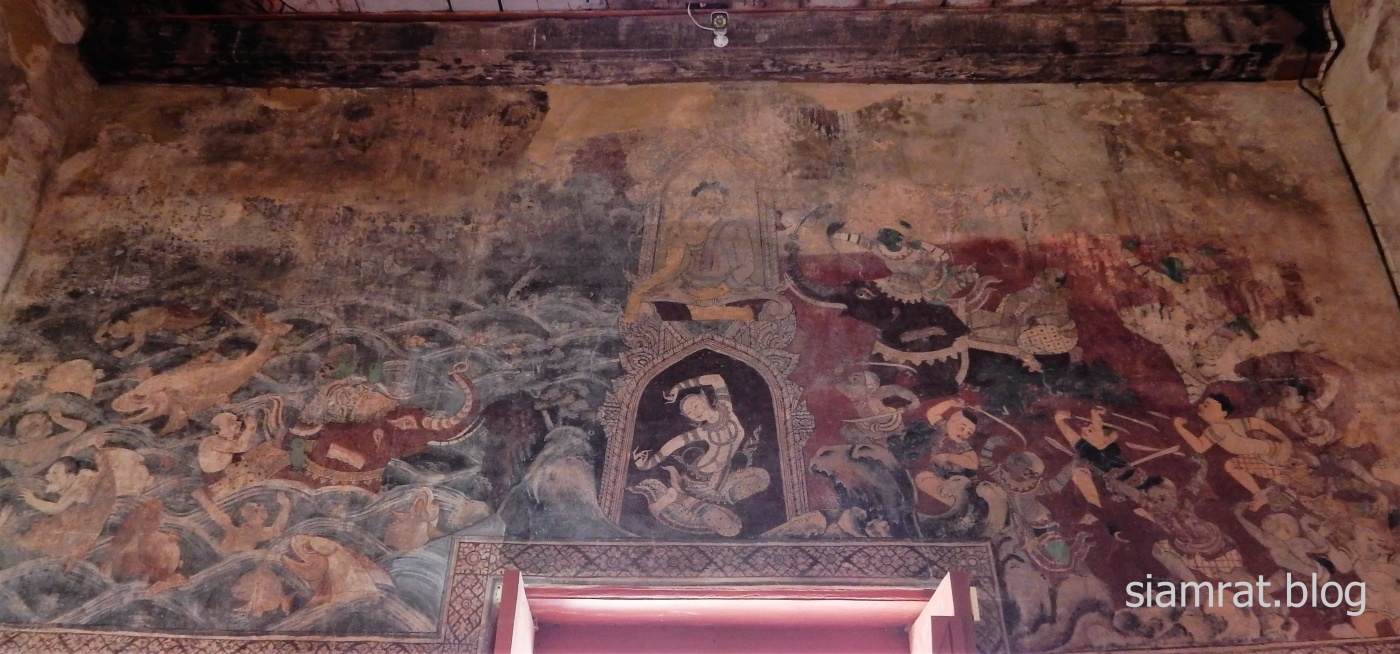As any visitor to Thailand quickly discovers, this country has a deep culture and history replete with miraculous tales of heroic deeds. Quite a few of these tales involve strong women who through bravery and sometimes a bit of powerful magic overcome adversaries and save their people from certain destruction. Here we look at some of the stories of the most famous of these heroines and how they have saved the day, or at least sometimes persuaded love-lorn men to rub mud on their heads or wear their loved one’s underwear as a hat.
Phra Mae Thorani
Phra Mae Thorani is a mythological “Mother Earth” goddess known throughout Thailand, Laos, Cambodia and Myanmar. She appears in the Maravijaya, the ninth story within the Pathamasambodhi scriptures which describe the Buddha’s life. Her image can be found frequently in Buddhist temples across the region.

In the Maravijaya tale the Buddha was meditating under a Bodhi tree when Mara, the Evil One, led a force of warriors and animals to attack the Buddha and prevent him from achieving enlightenment through his meditations. Mara himself rode upon an elephant and had one thousand arms each bearing a weapon. The Buddha reached down with his right hand and touched the ground to summon Phra Mae Thorani to bear witness to his good deeds. Thereupon the Mother Earth goddess rose up and proceeded to wring from her long hair the water that she had collected each time the Buddha had performed an act of virtuous generosity over a multitude of life times. The torrents of water from her hair, all derived from the good deeds of the Buddha, became a mighty flood and swept away the forces of Mara allowing the Buddha to continue his meditations and achieve enlightenment.

Phrae Mae Thorani’s intervention to defeat the forces of Mara is a popular topic for murals and statues in temples. She is also called upon for help by people in all sorts of situations such as by farmers to provide fertile soils and rain for crops or even by young men desperately seeking a bride, who can apparently invoke Phra Mae Thorani’s magic by scooping up some earth with the big toe of their right foot and with the right hand rubbing it into the top of their head.
Queen Chamathewi
Chamathewi was a Mon Queen who ruled over the indigenous Lawa people of northern Thailand in the seventh or eight century CE. Her life story has been handed down through a multitude of varying legends. Some of these stories suggest that as a child she was found and raised by the hermit Suthep who lived in a cave on top of the mountain now known as Doi Suthep. At the age of thirteen she was sent by Suthep to Lavo, modern day Lop Buri, where she was adopted by the royal family and raised as a princess. In due course she was married to the Mon ruler of a nearby vassal state.

Meanwhile the hermit Suthep went on to found the city of Haripunjaya, known to us today as Lamphun. The hermit requested that the King of Lavo send Princess Chamathewi to become the first ruler of the new city. Princess Chamathewi arrived in Haripunjaya without her husband but with a large retinue of Buddhist monks. Just after her arrival she gave birth to twin boys. The elder one Mahanta Yot eventually succeeded her as ruler of Lamphun, whilst the younger one Ananta Yot went on to rule another newly founded city called Khelanga, today known as Lampang.

By all accounts Chamathewi was very beautiful and various stories are told of how she rebuffed the unwanted advances of a Lawa King called Vilangkha. By one account when King Vilangkha requested the Queen’s hand in marriage she initially rudely rejected his request. When Vilangkha persisted she accepted but upon the condition that he could prove his worth by throwing a spear from the top of Doi Suthep into the walled city of Haripunjaya (A distance of about 23km !).
Queen Chamathewi however had underestimated the power of King Vilangkha’s magic and his first throw nearly reached its target. Worried by this the Queen resorted to her own black magic and presented Vilangkha with a hat secretly fashioned from her under garments, soiled with menstrual blood. Proudly wearing the new hat on his head Vilangkha was shocked to see his next throw fall far short of the target. Finally his third throw was so feeble that the spear was caught by the wind and returned to strike King Vilangkha through the heart. Memorials to King Vilangkha as well as the hermit Suthep can be seen at Wat Phra That Doi Kham, apparently the site of Vilangkha’s spear throwing. The temple itself was reputedly founded by Queen Chamathewi herself.

Queen Chamathewi possibly lived to be 89 years old. On her death her son King Mahanta Yot had her remains interred in the Suwana Changkot Chedi, very possibly the same chedi now known as Kukut Chedi in Wat Chamathewi in Lamphun. She is also commemorated in Lamphun by a statue designed by the famous Italian-Thai citizen Silpa Bhirasri (Corrado Feroci).
Queen Suriyothai
Perhaps the most famous tale of female heroism in the Thai annals is that of Queen Suriyothai of Ayutthaya. She was married to Prince Thianracha, son of King Chairacha of Ayutthaya. After King Chairacha’s death a short period of dynastic turmoil and intrigue was abruptly ended when the leading nobles assassinated the usurper to the throne and called upon Prince Thianracha to become King Chakkraphat in July 1548.
Just three months into Chakkraphat’s reign King Tabinshweti of Burma crossed the Three Pagodas Pass into Siam with an enormous army headed for the capital. By late 1548 the Burmese army was encamped just north of Ayutthaya at Lumpli plain. Accoring to Thai sources King Chakkraphat on his war elephant led his forces out of the city to engage with the Burmese accompanied by Queen Suriyothai and one of his daughters Princess Boromdhilok riding together on a smaller elephant. King Chakkraphat engaged the Burmese viceroy Thado Dhamma Yaza in one-on-one combat but his elephant took fright and fled whilst the Burmese leader took chase. Fearing for her husband’s life Queen Suriyothai charged forward to block the path of Thado Dhamma Yaza’s elephant. The Queen thus became engaged in combat and both she and her daughter were killed by spear blows. Both women were dressed in male military garb and it is said that the viceroy was unaware that he was fighting with women until the helmet fell from the Queen’s head. According to Thai legend the Queen’s sacrifice enabled King Chakkraphat to regroup his forces and ultimately repel the Burmese from the field.

Queen Suriyothai is commemorated by a large Chedi named after her located in the western part of Ayutthaya. Once thought to contain her ashes this belief has been called into doubt by recent scholarship. A more modern memorial perhaps was the block-buster movie “Suriyothai” which was financed by Queen Sirikit herself and initially released in 2001. Probably the most expensive movie ever made in Thailand, costing up to US$20 million, it was subsequently released in the US with the involvement of famous American director Francis Ford Coppola.
Thao Suranari
Our final heroine was known as Ya Mo (Grandmother Mo) and was the wife of the deputy governor of Korat in the early nineteenth century. Korat (Also known as Nakhon Ratchasima) at this time was an outpost of Siam’s power over Lao territories to the east. In 1828 the Lao King Anouvong invaded Siam’s territory with the objective of throwing off its vassal status. On reaching Korat the Lao army succeeded in capturing the city and subsequently began the process of transferring the population into Lao territory.

However the Lao forced their Thai female prisoners to cook for their troops and Ya Mo took this opportunity to request knives from their captors for the purpose of food preparation. But at night when the troops slept Ya Mo passed the knives to the captured Thai soldiers who then took their Lao guards by surprise and escaped.
In due course King Phra Nangklao’s (Rama III) army arrived from Bangkok and defeated King Anouvong’s forces. The Lao were pushed back to Vientiane which was eventually completely destroyed by the Siamese and left depopulated for the rest of the nineteenth century.
King Phra Nangklao recognised the bravery of Ya Mo by bestowing upon her the title Thao Suranari meaning “Brave Lady”. In 1934 a statue, again sculpted by Silpa Bhirasri, was erected in the centre of Korat. This continues to be the focus of daily popular devotions as well as being the centre of festivities held each year at the end of March to commemorate Ya Mo’s brave actions.
References
- A Brief History of Lanna, Hans Penth, Silkworm Books, 2004.
- Thailand A Short History. David K. Wyatt, Silkworm Books, 1984
- Monks and Magic. B.J. Terwiel, White Lotus Press, 1994
- The Buddhist World of Southeast Asia. Donald K. Swearer, State University of New York Press, 1995
- The Legend of Queen Cama: Bodhiramsi’s Camadevivamsa, a Translation and Commentary. Donald K. Swearer and Sommai Premchit, State University of New York Press, 1998
- https://en.wikipedia.org/wiki/Camadevi
- https://en.wikipedia.org/wiki/Suriyothai
- https://en.wikipedia.org/wiki/Thao_Suranari
- https://en.wikipedia.org/wiki/Anouvong
